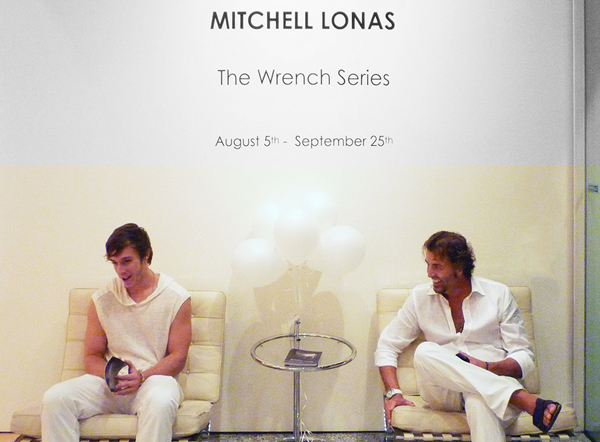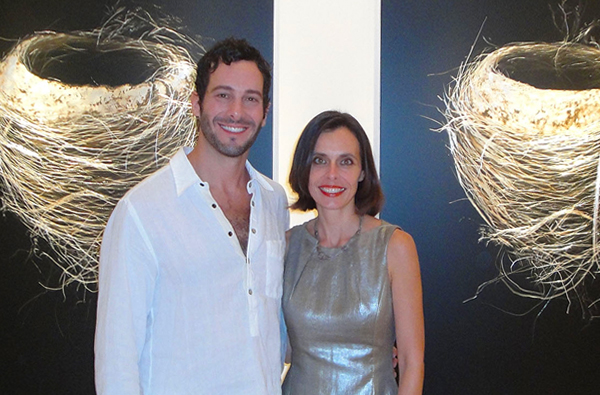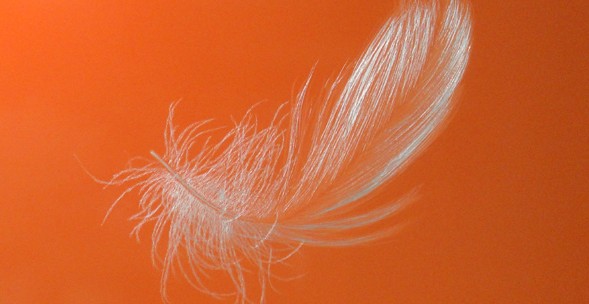
All posts by Gary Crossey
PRESS RELEASE: Undercurrents
 In a serenely poetic follow-up to his 2010 debut with the gallery, Mitchell Lonas presents Undercurrents, a suite of visually stunning works on incised aluminum panel. The pieces incorporate three interrelated motifs—root systems, bird nests, and floating feathers—which Lonas, using customized tools, incises into painted aluminum surfaces.
In a serenely poetic follow-up to his 2010 debut with the gallery, Mitchell Lonas presents Undercurrents, a suite of visually stunning works on incised aluminum panel. The pieces incorporate three interrelated motifs—root systems, bird nests, and floating feathers—which Lonas, using customized tools, incises into painted aluminum surfaces.
Fluid yet impeccably precise, his gestures create arcing lines that shimmer and gleam like gemstones or fiber-optic lights as the viewer moves around the room. The imagery references the simplicity, gentility, and elemental kindness of Southern culture, ingrained in Lonas since his childhood in the Smoky Mountain foothills of eastern Tennessee.
“The work in this show,” he explains, “is about a continuing connection to nature and family. It’s about putting down roots, uprooting, and knowing we have a network, even if we can’t see it, that is constantly nourishing not only our bodies, but also our spirits.”
Lonas, who studied art history at the University of Tennessee in Knoxville, is featured in significant private, public, and corporate collections, and has been commissioned to create large-scale works for Fortune 500 companies such as Nordstrom department stores. In the current series, iconic motifs hover in the centers of inky-black picture planes. Roots branch out like fingers, lightning bolts, or diagrams of the human circulatory system; nests come together out of of leaves, twigs, and tiny flowers; and downy feathers hover on unseen air currents. This iconography, culled from the plant and animal worlds, nevertheless reminds us of our human bonds: those who came before us, the comfort of home, and the journey to independence. Lonas gained inspiration for Undercurrents from the 34th stanza of the I Ching, which likens roots to “a foundation to dance on” and suggests that in order to fully experience our compassion and humanity, we must “go down to the very foundations of life.” With this as a symbolic backdrop, the artist deploys an astonishing technical prowess to remind us of an essential truth: Even in the media-saturated din of contemporary life, it is the simple gifts of family and the earth that make us who we are.
CALLAN CONTEMPORARY hours are Tuesday-Saturday, 10 am-5 pm. For more information, please contact gallery owner Borislava Callan at 504.525.0518 or visit our website at www.callancontemporary.com.
Written by: Richard Speer.
The author of the biography Matt Lamb: The Art of Success (John Wiley & Sons), Speer is contributing critic at ARTNews and Art Ltd. magazines. His essays have appeared in The Los Angeles Times, The Chicago Tribune, The Huffington Post, Newsweek, Salon, and Opera.
EVENT: Counterparts
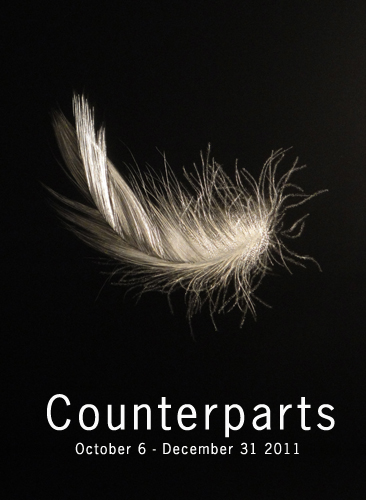 Mitchell Lonas returns to Blue Spiral 1 gallery, Asheville NC for the “Counterparts” show, October 6 2011 – December 31 2011.
Mitchell Lonas returns to Blue Spiral 1 gallery, Asheville NC for the “Counterparts” show, October 6 2011 – December 31 2011.
Opening Reception
Thursday October 6th 2011 – 5-8pm
Lonas’ work tapped for ‘Twilight’ movies
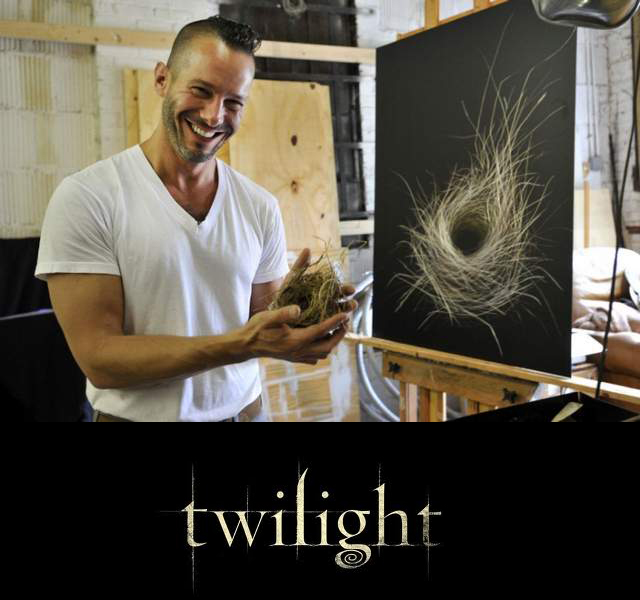
ASHEVILLE — Kathy Lonas had no idea what the nest she found on her farm would do for her son’s career. But it became the focal point of hundreds of works of art by Mitchell Lonas, a resident artist in Asheville.
Then, last November, the set director of the popular “Twilight” movie series found one of those nest paintings in Gallery Bienvenu in New Orleans.
The gallery called Mitchell Lonas on his birthday, Nov. 18, and told him that the set director of “The Twilight Saga: Breaking Dawn” might want his nest painting for the movie’s set. And that the set director might want to commission him to make another one like it to make a pair.
 A few months later, it was confirmed. Even though the 6-feet-by-4-feet paintings of robins’ nests would have to be shipped to the movie set in Canada, the set director “wasn’t interested in anything else.”
A few months later, it was confirmed. Even though the 6-feet-by-4-feet paintings of robins’ nests would have to be shipped to the movie set in Canada, the set director “wasn’t interested in anything else.”
The paintings will probably float in front of a large-scale window across from the entryway to the Cullens’ house in the fourth and fifth “Twilight” movies, according to Mitchell, who is ecstatic about the whole string of events.
It all started when Lonas, who predominately painted portraits after graduating from the University of Tennessee in Knoxville with an art degree, pulled out a nest his mother had given him.
In his basement studio, with a shiny piece of aluminum placed on his easel and a light above it, Lonas started carving the image of a nest into the metal.
“I got really emotional, and I knew I was onto something,” he said.
The nests are a tribute to his mother, he said, the kindest person ever in Lonas’ book. “I think a lot of times, energetically I try to put feelings from my mother — my sense of home — in my work,” he said.
Back in 1998, long before any of his nest creations, his mother showed him three or four nests she had found on their property.
Kathy Lonas said one of the nests was made completely out of their two horses’ hair — a red horse and blonde horse — all wound together and “mingled” together into a nest home.
“It’s so exciting to see a little bird carry a limb or branch and build a home,” she said.
She showed them all to him, he loved them, and she told him they were probably from a “wrench.” Her son told her that she was probably combining the word “wren” and the word “finch.” They both laugh about it now.
It turned out to be a swallow’s nest that would change Mitchell Lonas’ artistic career completely.
He had long carried those nests with him, but in that basement he finally discovered how he wanted to share them with others.
Within a few weeks, he had a whole show put together. “I ended up calling the show the ‘Wrench Series,’” he said with a grin.
The initial creation Lonas made on aluminum, which he keeps in his studio, doesn’t show off the glint or starkness of the nests, but now he gets his aluminum pieces powder-coated with an opaque black or white paint covering. Then he uses customized cutting tools to incise designs into the aluminum.
The result? “The light catches different parts, showing off different lights,” Lonas said.
Also, the dark, empty space or “negative” space in the paintings gives one’s eye a place to rest, according to the artist. He noted how a lot of paintings force one’s eye to see everything too obviously.
According to Lonas, gallery owner John Cram phrased the way a nest inspires best of all. “The nest is a precarious thing. It sets into mind the ideas of security,” Cram said. “It’s not about abandonment — it’s about security and home.”
Lonas also carves trees and floating feathers into his metal canvases once in a while. “Nature gives us the most to work with,” he said. “As a mother wants her child to leave, she lets a few feathers out of the nest.”
Lonas is doing what he loves, but he never realized that his passion would generate as much work as it does. “The moment I finish things, they go out,” he said.
Right now, he is working with the retail store Nordstrom, creating seven to 12 paintings for every new store they build.
That also increases his visibility as an artist, he said.
While busy with work, Lonas said he won’t miss the premiere of “The Twilight Saga: Breaking Dawn, Part 1”later this year.
Article Written by: Adrienne Belz
Link to News Article
NEWS: Cover Artist – Laurel of Asheville

COVER ARTIST: Mitchell Lonas
Mitchell was honored to be selected as the Cover Artist for the November 2010 publication of The Laurel of Asheville.
Thank you for the supportive responses and comments. Paul M. Howey captivating article chronologies Mitchell journey and attraction for “making pictures”.
“I can’t remember a time I wasn’t interested in painting. I was forever outside drawing everything I could find. I was always trying to find beauty in the things I saw as a child.” He says he doesn’t recall ever taking naps with the other kids in kindergarten. “Instead, the teachers were always giving me poster boards and paint and I was always making pictures,” says Mitchell.
Read Article: Mitchell Lonas – Cover Artist – Laurel of Asheville
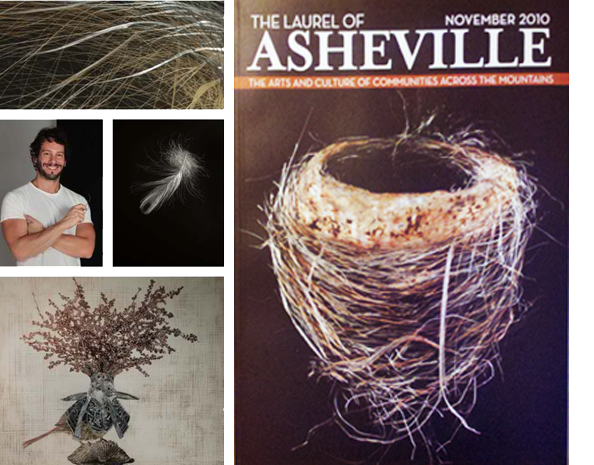
NEWS: N.O.A.R. Art Review

ART REVIEW: Wrenched
Written By: Kathy Rodriguez
At first glance, Mitchell Lonas’ work is three-dimensional. In the introductory piece to his show – The Wrench Series No. 33 – and most of its successors, a two-dimensional frame confines an absorbent black abyss from which tendrils of fine silver wire appear to thread their ways outwards. They are like streaked light eking out from an iridescent nebula made a cloudy tangle of line, which, though floating off-center in deep space, anchors light to itself. The shape and mark-making that creates the nebula evokes a nest, a whirl of threads spun together to enclose and hold space. This first impression, however is mostly an illusion.
In actuality, the works in the “Wrench Series” at Gallery Bienvenu are strictly two-dimensional. Lonas adapts the centuries-old sgraffito technique of scratching through a black background to reveal a contrasting image. Shining threads of metal sheeting and faint patinas of soft color hidden beneath the darkness meet light after being found through excavation of the surface. When light hits the curvature of the revealed lines, the threads that form the nest shapes seem to remove themselves from the picture plane and push into our space. But, the only sculptural element is the faint burr left ridged in the substrate by the carving tool. As critic Richard Speer notes, the simplicity and straightforwardness of the meditative marks recalls the austerity and delicacy of Japanese ink painting and calligraphy. There is a suddenness that suggests moments of Zen-like enlightenment in unkempt “threads” spraying from otherwise meticulously woven networks of line. Their seeming spontaneity evokes the moment of finding a nest tucked in the branches of a tree. They are surprising and fresh, and result in images that are compellingly mysterious and almost without precedent.
The wrench is a fictional bird created by Lonas’ mother, who found a nest made of hair from his father’s horse and gave it to the artist. In a short video created for the artist by the Our Voice agency in Asheville, North Carolina – where the artist resides and for which he participated in an auction – Lonas reveals that, when asked what bird created it, his mother mistakenly combined the words “finch” and “wren” into the name for one mythical animal. In this show, Lonas displays three of these tiny horse-hair “wrench nests” like precious artifacts. They sit underneath a plexiglass case, protected and pristine. As art from nature, they are marvelously prefect in their construction, immediately reminiscent of home, safety, and evoke the care and time taken to create them. It is easy to image an egg softly cupped in these forms, protected by a watchful mother.
The tree from which some nests came is reproduced in Southern Yellow Pine, which hangs at the rear of the gallery. Its white background and delicate line work makes it unlike everything else, appearing quieter than the other works. In the design of the show, this piece has the sense of the mother who once provided nests to her young. Tucked away in the corner, it is unlike and separate from what she helped nurture. Though formally different than the other pieces, it seems appropriately included in the lineage and progression of the work.
The disparity between the softness of the actual nests and the sharp contrasts of the hanging pieces enhances the sense of difference and separateness suggested by the tree. Void and loss are contained in the spaces embraced by the cut lines, which, though delicate, also slow the raggedness of the tools made to use them. The sharp contrast also suggests a kind of scientific inquiry; the nest in the hanging pieces seem to float outward from a background to which they might be pinned, like a specimen on display. The images are separated from their natural environments through representational, two- dimensional reproduction and through their isolation in negative space. In a sense, Lonas seems to investigate the forms he chooses as much as celebrate and reinvent their beauty with his glimmering materials.
The titles create a kind of taxonomy that furthers the idea of scientific observation and categorization. Lonas specifies the shapes of nest by type of bird, as in Robin Nest No. 1. This form is densely knit lines that swirl towards a solid rim and enclose a long and narrow space. In contrast, Carolina Wren Nest loosely encircles a soft, dark space accented by wild tendrils. The peculiarity of each form suggests the uniqueness of home, of individual protection and nurturing met distinctly through the features of these structures. Other nests are given only numbers, indicating one in a series, such as Nest No. 404; it is like the natural nest under the plexiglass in shape, but seems more generalized than others by its mechanical reproduction on panel. This is perhaps to suggest that sometimes, home is wherever it can be found, or taken.
Lonas states that his aim was to create “something original” through unconventional means. While there are formal precedents for the work, the objects that result from his process are neither painting nor drawing nor sculpture. They are in a category by themselves. The contrast in both the uniqueness of their making. They embody oppositions of lost and found, occupied and abandoned, floating and grounded. The tension is part of their beauty, as is the mystery of the illusion of space they create and the unlikely combination of material and effects. Lonas has created an intriguing body of work that suggests both the familiarity of home and displacement from it, summing up a drama of existence in what ultimately reads as a quiet spindle of threaded experiences.
Gallery Bienvenu Opening
Gallery Bienvenu
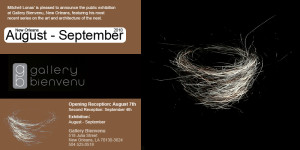
OPENING: The Wrench Series
Paths
When starting a new art project, Mitchell Lonas spends time finding shapes and patterns that interest him.
During a recent study Mitchell captured the shape of paths created in long grass and wheat fields. As Mitchell observed the array of patterns he noticed how some paths are silimar to those in life, in that they just come to an end, while other paths over lap and become more complex.
Photography by Mitchell Lonas
[nggallery id=27]
PRESS RELEASE: The Wrench Series
 Several years ago in the foothills of the Smoky Mountains, artist Mitchell Lonas laid eyes on something of such uncanny beauty, he has never forgotten it: a trio of swallows’ nests, which the birds had fashioned solely from horse-tail hairs. The nests, each a different color, were so improbable in their architectural intricacy and gossamer sheen, they filled Lonas with the inspiration to transmute common natural phenomena such as nests, feathers, and trees into the stuff of aesthetic rapture. These motifs are central to The Wrench Series, the artist’s debut exhibition at Gallery Bienvenu. To create the works, he employs a unique process to apply paint to steel and aluminum panels.
Several years ago in the foothills of the Smoky Mountains, artist Mitchell Lonas laid eyes on something of such uncanny beauty, he has never forgotten it: a trio of swallows’ nests, which the birds had fashioned solely from horse-tail hairs. The nests, each a different color, were so improbable in their architectural intricacy and gossamer sheen, they filled Lonas with the inspiration to transmute common natural phenomena such as nests, feathers, and trees into the stuff of aesthetic rapture. These motifs are central to The Wrench Series, the artist’s debut exhibition at Gallery Bienvenu. To create the works, he employs a unique process to apply paint to steel and aluminum panels.
Then, working from sketches, he uses customized cutting tools to incise the picture planes with iconic imagery, the beveled lines glinting as viewers behold the pieces from different vantages. “You walk in front of them,” he explains, “and the light travels with you. There’s a sparkle, a feeling of movement. It’s almost a fiber-optic effect.”
Lonas, who studied art history at the University of Tennessee in Knoxville, was a respected portrait painter before transitioning to his current style. A portraitist’s sense of focus, line, and beauty continues to inform his new work, which is included in notable private, public, and corporate collections, among them a series of large-scale commissions for Nordstrom department stores. An avid hiker and birdwatcher, he is compelled to portray nature in ways that are both poetic and inventive. “The challenge,” he reflects, “is to create something original using unconventional materials and
methods.”
The artworks’ gestural drama is tempered by a hushed, Zen-like serenity, heightened by an intuitive use of negative space that recalls Asian sumi-e brush painting. Immaculately presented with hidden cleats that make the works appear to float in front of the wall, the incised paintings have a weightless, ethereal quality and a sculptural presence that is contemporary but not cold. In these semi-abstracted celebrations of the natural world, viewers will find a treasure trove of symbolisms and personal narratives, which lend themselves to extended contemplation and interpretations as varied as nature itself.
Gallery Bienvenu hours are Tuesday through Saturday, 10:00 a.m. to 5:00 p.m. Please contact Borislava Kharalampiev, Gallery Director, or Cathy Bienvenu, for additional information or visit the gallery website at www.gallerybienvenu.com.

